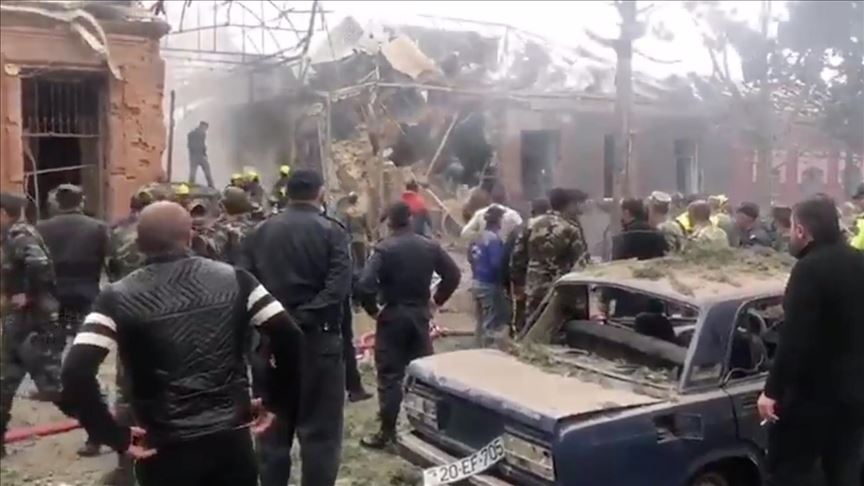'Armenia attacking Azerbaijani cities to provoke Baku'
Yerevan's declaration of readiness to strike cities crossing red line, says Russian military expert
 A screen grab captured from a video shows a view of a residential area damaged by the clashes between Armenia and Azerbaijan on October 04, 2020 in Ganja, Azerbaijan. Many buildings in Fuzuli, Terter and Aghdam regions were damaged in the attacks carried out allegedly by the Armenian army. ( AA Video - Anadolu Agency )
A screen grab captured from a video shows a view of a residential area damaged by the clashes between Armenia and Azerbaijan on October 04, 2020 in Ganja, Azerbaijan. Many buildings in Fuzuli, Terter and Aghdam regions were damaged in the attacks carried out allegedly by the Armenian army. ( AA Video - Anadolu Agency )
ANKARA
Armenia's attacks on civilians in Azerbaijani cities are aimed to provoke Baku, a Russian military expert said on Sunday.
"[Armenian Prime Minister Nikol] Pashinyan's tactics: strikes on Azerbaijani cities to provoke a retaliatory strike in Armenia, and then become a 'victim of aggression' in front of Russia and the CSTO [Collective Security Treaty Organization] for help?" Igor Korotchenko, the chief editor of Russia’s National Defense magazine, said on Twitter.
Armenia is a member of a military alliance of six former Soviet states, including Belarus, Kazakhstan, Kyrgyzstan and Tajikistan. Russia also has a military base in Armenia.
Azerbaijan said Armenian armed forces have shelled its second largest city Ganja, escalating the conflict which flared up last week.
The border clashes broke out Sept. 27 when Armenian forces targeted Azerbaijani civilian settlements and military positions in occupied Upper Karabakh, leading to casualties. The fighting still continues.
Korotchenko, who also heads the World Arms Trade Analysis Center, said strikes must not be carried out against civilians and their property but it is impossible to completely avoid this during military operations.
"But the official declaration of readiness to strike at cities is already crossing the red line," he said, urging the International Court of Justice to investigate the violations.
He argued that the announcement by Arayik Harutyunyan, the so-called head of the unrecognized "republic" formed in Upper Karabakh, of attacking Azerbaijani cities was tantamount to terrorism.
Considering that the Armenian military formations in Nagorno-Karabakh do not have high-precision weapons, Korotchenko said striking Azerbaijani cities means killing civilians and destroying their houses.
Attacks on Ganja city
The Armenian Armed Forces have resorted to shelling the densely populated residential areas of Ganja, which has over half a million population, according to the country's Defense Ministry.
In a statement, it said the armed forces are firing rockets in Fuzuli region from Armenia, and heavy artillery in Aghdam and Terter regions from "occupied territories."
"As a result of enemy fire, civilians, civilian infrastructure, and ancient historical buildings were harmed."
Azerbaijan's Defense Minister Zakir Hasanov said shelling Azerbaijan's territories from Armenia is "provocative and expands the zone of hostilities."
The ministry issued another "warning to the enemy," saying that over the past two days the Azerbaijan army, and human settlements are being subjected to "intensive shelling" from Ballija, north of Khankendi.
"Despite several warnings to the enemy by means of the representatives of international organizations, this is still ongoing. We once again warn the enemy that we will take adequate measures against the enemy positions in Ballija," it said.
'Residents more than strong'
Hikmet Hajiyev, assistant to Azerbaijan's president, on Twitter said: "Indiscriminate missile attacks are launched against Ganja, Fuzuli, Tartar and Jabrayil cities of Azerbaijan from territory of Armenia."
He also shared a video footage of the destruction caused by the attacks.
"Azerbaijan retains its right to take adequate measures against legitimate military targets to defend civilians and enforce Armenia to peace. 4 new missiles just hit Ganja," he said, adding that the attacks will not intimidate the residents.
"I talked to the people in Ganja. Residents are more than strong. Such irresponsible missile attacks with cluster munitions from Armenia can in no way intimidate them."
Speaking to the state-run Azertac news agency, Hajiyev said Armenia’s political-military leadership continues to carry out "war crimes" against Azerbaijan.
“During recent days, over 10,000 pieces of projectiles and missiles of various types were launched on Azerbaijan’s densely populated settlements. Over 500 private houses were completely destructed or seriously damaged," he claimed.
The foreign policy chief for Azerbaijan's Presidency underlined that the "massive bombardment" is "deliberate."
"The systematic bombardment of residential settlements by Armenia proves that this plan has been prepared preliminarily, and included in combat and firing program of the Armenian armed forces."
Upper Karabakh conflict
Relations between the two former Soviet republics have been tense since 1991, when the Armenian military captured the region also known as Nagorno-Karabakh. It is an internationally-recognized territory of Azerbaijan.
About 20% of Azerbaijan’s territory, including the Upper Karabakh, has remained under Armenian occupation for nearly three decades.
Multiple UN resolutions, and other international organizations demand the withdrawal of the occupying forces.
The towns occupied in Upper Karabakh are Shusha, Khankendi, Khojaly, Asgaran, Khojavand, Aghdara, and Hadrut.
Lachin, Kalbajar, Aghdam, Fuzuli, Jabrayil, Qubadli, and Zangilan are seven other invaded regions surrounding it.
During the conflict in the 1990s, over a million Azerbaijanis were internally displaced, while 20,000 got martyred and 50,000 wounded and disabled, according to official figures.
While at least 4,000 Azerbaijanis remain missing, more than 2,000 others were taken hostage by Armenian forces.
The OSCE Minsk Group -- co-chaired by France, Russia, and the US -- was formed in 1992 to find a peaceful solution to the conflict, but to no avail. A cease-fire was agreed upon in 1994.
Many world powers have urged an immediate halt to the clashes.
Anadolu Agency website contains only a portion of the news stories offered to subscribers in the AA News Broadcasting System (HAS), and in summarized form. Please contact us for subscription options.







